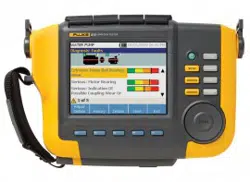Loading ...
Loading ...
Loading ...

C-1
Appendix C
Glossary
Acceleration. The rate of change of velocity, often
depicted as “g’s” or in “mm/s2” in the metric system or
“in/sec2” in the English system. Acceleration is not
constant but will vary through the vibration cycle, reaching
maximum levels as velocity reaches its minimum. This is
typically when a particular mass has decelerated to a stop
and is about to begin accelerating again.
Accelerometer. A transducer whose electrical output
responds directly to acceleration. Accelerometers
typically cover a much wider frequency range, allowing
them to pick up signals not present with other types of
transducers. Due to their frequency range,
accelerometers are ideal for most types of rotating
equipment, making them the most commonly used
transducer for vibration measurements.
Alignment. A condition where components within a drive
train are parallel or perpendicular, according to design
requirements. The Tester can diagnose misalignment
conditions where these components are no longer aligned
according to design requirements, causing excessive
bearing wear and power consumption in the machine.
Amplitude. The size or the magnitude of the vibration
(displacement or velocity or acceleration). Peak-to-peak,
zero-to-peak or Root Mean Square (RMS) can be used to
express velocity terms. In general, “Peak-to-peak” is used
for displacement, “Zero-to-Peak” is used for velocity and
RMS is used for acceleration. In the Tester’s diagnostic
details, amplitude indicates the magnitude of each cited
peak in velocity terms.
Axial. One of the three vibration axes (Radial, Tangential
and Axial), the axial plane is parallel to the centerline of a
shaft or turning axis of a rotating part.
1.888.610.7664 sales@GlobalTestSupply.com
Fluke-Direct.com
Loading ...
Loading ...
Loading ...
